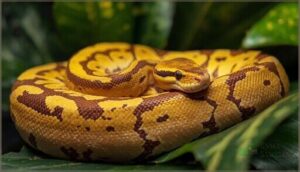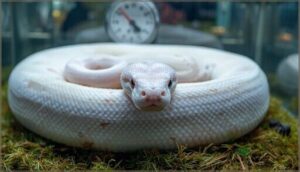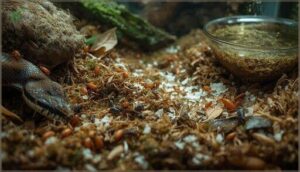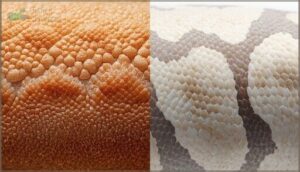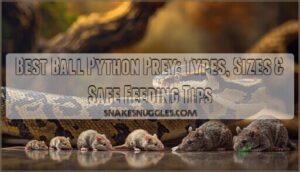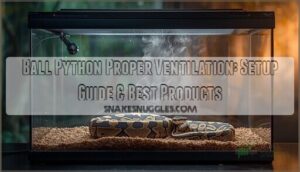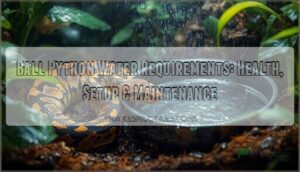This site is supported by our readers. We may earn a commission, at no cost to you, if you purchase through links.
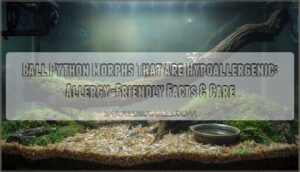
Science confirms what many herpetologists have suspected for years—ball python morphs that are hypoallergenic stand apart from typical pet choices due to their unique genetics and lack of allergy-provoking proteins.
With a dizzying array of color morphs, these gentle snakes offer beauty and comfort, opening the door to pet ownership for those who once thought allergies closed it forever.
Table Of Contents
Key Takeaways
- Ball pythons are naturally hypoallergenic because their scales lack the proteins and oils that trigger most pet allergies.
- Most allergic reactions in snake owners come from feeder insects or poor enclosure hygiene, not from the snakes themselves.
- Hypo, Albino, and Lavender Albino ball python morphs are especially good choices for sensitive owners due to their stable, low-allergen shedding.
- Regular cleaning, frozen-thawed feeding, and air quality management are key to creating an allergy-safe home for your ball python.
Are Ball Pythons Actually Hypoallergenic?
If you’re wondering whether ball pythons are truly hypoallergenic, you’re not alone. Many folks with allergies hope for a pet that won’t trigger sneezing or itchy eyes.
Let’s look at what makes these snakes a smart choice for sensitive households.
Scientific Evidence on Reptile Allergens
Curiosity about ball python allergies leads us straight to protein science. Unlike mammalian pets, snakes lack the sebaceous proteins that cause most sneezing fits. Recent studies spotlight reptile parvalbumins—muscle proteins—with rare allergic potential, mainly in those already sensitive to fish.
Venom allergies are exceedingly uncommon, while repeated exposure to snake venom can trigger anaphylactic reactions in some individuals.
Genetics and environmental factors make the Hypo ball python a standout for hypoallergenic pet care.
Comparison to Mammalian Pets
Picture a typical household with a furry pet: dander floats around, allergens linger on clothes, and allergy sufferers often pay the price. Ball pythons, on the other hand, offer a welcome change. Their unique genetics and keratin scales eliminate dander production, resulting in negligible sensitization rates and dramatically improving quality of life—especially compared to mammalian pets.
Unlike furry pets, ball pythons offer allergy sufferers relief by producing no dander and creating a cleaner, more comfortable home
Reptiles like ball pythons are naturally hypoallergenic pets due to their cold-blooded nature.
Clinical Studies on Snake Allergies
Compared to furry pets, studies on Venom Allergy and IgE Sensitization consistently show ball python morphs—regardless of color variations or genetic background—don’t trigger direct allergic responses in most people.
In fact, clinical Case Reports and analyses of Exposure Pathways and Molecular Mechanisms confirm snake genetics and traits, including those of popular morphs, rarely provoke reactions associated with allergies.
Which Ball Python Morphs Are Best for Allergy Sufferers?
If you’re wondering which ball python morphs are best for folks with allergies, you’re in the right spot. Some morphs stand out when it comes to keeping things allergy-friendly.
Let’s look at a few options that are especially gentle on sensitive systems.
Hypo (Hypomelanistic) Morph Characteristics
Ever wondered what sets a Hypo Ball Python apart? The Hypomelanistic morph boasts striking melanin reduction, turning bold blacks into faded yellow and orange tones.
You’ll notice cleaner pattern clarity and more visible golden highlights. In scale analysis, fewer dark pigments mean smoother contrasts. That’s partly why the Hypo remains a market popularity winner among Ball Python morphs.
Albino Morph Genetics and Allergen Levels
Through the lens of reptile genetics, albino Ball Pythons owe their unique coloration to TYR gene mutations, which block melanin synthesis. Melanin deficiency doesn’t alter skin protein structure or raise reptile allergen levels.
The morph’s stability and low-protein shedding keep environments cleaner for allergy sufferers—just as you’d expect from a classic Hypo Ball Python.
Lavender Albino Morph Benefits
While Lavender Albino Ball Pythons stand out for their hypopigmented coloration, their benefits go far beyond looks. You gain:
- Low allergen levels for sensitive owners
- Calm temperament benefits—ideal for stress-free handling
- UV sensitivity awareness for safer captive care
- Breeding success rates match other morphs
- Clear, lasting color morph descriptions—showcasing true diversity in snake color variations
What Causes Allergic Reactions in Snake Owners?
Allergies around snakes often have more to do with what goes into their enclosure than the snakes themselves. Feeder insects and how you manage the setup both play a big part. Here’s what you’ll want to look out for next.
Feeder Insect Allergens Vs. Snake Allergens
If you’re puzzling over itchy eyes after getting a snake, here’s the twist: Insect Allergenicity is the real culprit. Snake Protein Allergens rarely cause issues, even with hypopigmented or color morph variations. Most clinical incidence traces back to cross-reactivity from feeder insects, not ball python skin. It’s a common controversy—but the science is clear.
| Source | Common Reaction Type |
|---|---|
| Feeder Insects | Asthma, skin irritation |
| Ball Python Proteins | Very rare allergy events |
Environmental Contamination From Live Feed
Here’s the real controversy: live feeder rodents turn your snake’s terrarium into a hotbed for pathogens. High-density environments and cross-species cohabitation increase Pathogen Transmission Risks from environmental sources.
Bacteria persist, especially when Hygiene Protocols slip, compromising Ball Python Health—even in proven lines.
Clear shed or not, breeding for hypo morphs won’t stop contaminants from thriving after a live meal.
Frozen-thawed Feeding Advantages
Switching to frozen-thawed prey is like putting your ball python’s menu on autopilot: you get parasite reduction and reliable hygiene control, slashing contamination concerns that often haunt breeding lines.
Nutritional consistency stays on point, while welfare outcomes soar as injuries drop to zero.
Plus, economic efficiency sweetens the deal—Hypo and Proven Lines both benefit when you prioritize safe feeding.
How Snake Skin Differs From Mammalian Allergens?
Not all animal skin works the same way with regard to allergies. Snake scales bring their own features that set them apart from fur or feathers.
Let’s take a look at what’s different about ball python skin and why it matters for allergy concerns.
Keratin Structure in Ball Python Scales
Ever wonder what makes a ball python’s skin so unique—and less likely to stir up allergies? Ball pythons showcase a striking mix of beta- and alpha-keratin, giving their scales striking integrity and beautiful body patterns. Evolution set their scale keratin types apart from mammals, creating hypoallergenic properties and distinctive morph characteristics. It’s truly nature’s specialized armor.
- Beta-keratin provides protection and structure for Ball Python appearance
- Alpha-keratin lends flexibility, especially in curved body regions
- Genetic adaptation leads to striking Ball Python morph characteristics
- Scale integrity roles guarantee durability and glossy Ball Python body patterns
- Hypoallergenic keratin properties make handling safe for allergy sufferers
Absence of Sebaceous Glands
What sets your ball python apart from furry pets isn’t just its beautiful scales—it’s the total gland absence beneath. Snakes simply don’t have sebaceous glands.
That means there’s no oily dander or skin secretions drifting through your home.
This evolutionary basis for allergen reduction explains why Ball Python morph characteristics and appearance remain gentle on your body—and your allergies.
Protein Composition Analysis
Beyond a lack of skin oils, ball python scales are mostly beta-keratins—not the allergy-prone alpha-keratins found in cat or dog dander. The full proteome shows unique proteins, but none mirror the key allergens found in mammals.
Hypo, or Ghost Ball Python lines, don’t introduce immunoreactive venom proteins or muscle parvalbumins, making allergy cross-reactions extremely rare.
Best Practices for Allergy-Free Ball Python Care?
Caring for your ball python doesn’t have to be stressful if you’re worried about allergies. A few simple choices can help create a safe, comfortable home for both you and your snake. Let’s take a look at the best ways to keep your setup allergy-friendly.
Terrarium Hygiene Protocols
For keeping your Hypo Ball Python healthy—and your air clean—routine matters. Spot cleaning every few days nips odor and dust in the bud. Disinfection agents like a diluted bleach solution or chlorhexidine help control microbes.
Replace substrate at every deep clean and check humidity, since improper environmental parameters can boost allergens. Even vivid color patterns don’t affect hygiene needs.
Feed Selection Strategies
If you keep a Hypo or Ghost Ball Python, your choice of prey matters as much as your cleaning routine. Feeding frozen-thawed rodents over live ones cuts down allergen spread. Follow these five guidelines for smooth, allergy-safe feeding:
- Choose high Source Quality
- Rotate Prey Item Diversity
- Focus on Nutritional Value
- Prioritize Allergen Reduction
- Maintain steady Feeding Frequency
Air Quality Management
Through strategic air quality management, you set your Hypo Ball Python up for long-term comfort and well-being. HEPA Filtration captures fine particles and reduces allergen load, while precise Humidity Control aids shedding.
Keep VOC Mitigation in mind by limiting plastics, and maintain Temperature Stability. Regularly removing contaminant sources preserves the pastel hues and clean environment that highlight your Hypo’s unique traits.
Frequently Asked Questions (FAQs)
How often should ball python enclosures be deep cleaned?
Think of your snake’s enclosure like a garden—nurture it regularly, and it thrives.
For most setups, deep cleaning is smart every two to three months, adjusting the cleaning frequency for substrate types, feeding habits, and health risks.
What are common early allergy symptoms in handlers?
Common early allergy symptoms in handlers include skin reactions like redness or rashes, quick dermatitis onset, and mild respiratory issues such as coughing or a tickly throat.
Exposure risks and symptom frequency may increase with certain feeder insects.
Are juvenile ball pythons different in allergen risk?
Juvenile ball pythons aren’t exactly allergen factories, but their rapid growth brings more frequent shedding and secretion variability.
Small juvenile enclosures hold more allergen per inch, so exposure impact rises.
Reducing exposure is key, Hypo or not.
Conclusion
It’s ironic—what seems most unusual about ball python morphs that are hypoallergenic is how naturally they fit into the lives of allergy sufferers. These snakes break the mold, offering both striking colors and peace of mind with their low-allergen bodies.
Their unique biology gently rewrites the definition of a “pet.” If you’ve been searching for companionship without compromise, a ball python may be waiting—quietly, patiently—just out of sight, ready to make your home truly your own.

